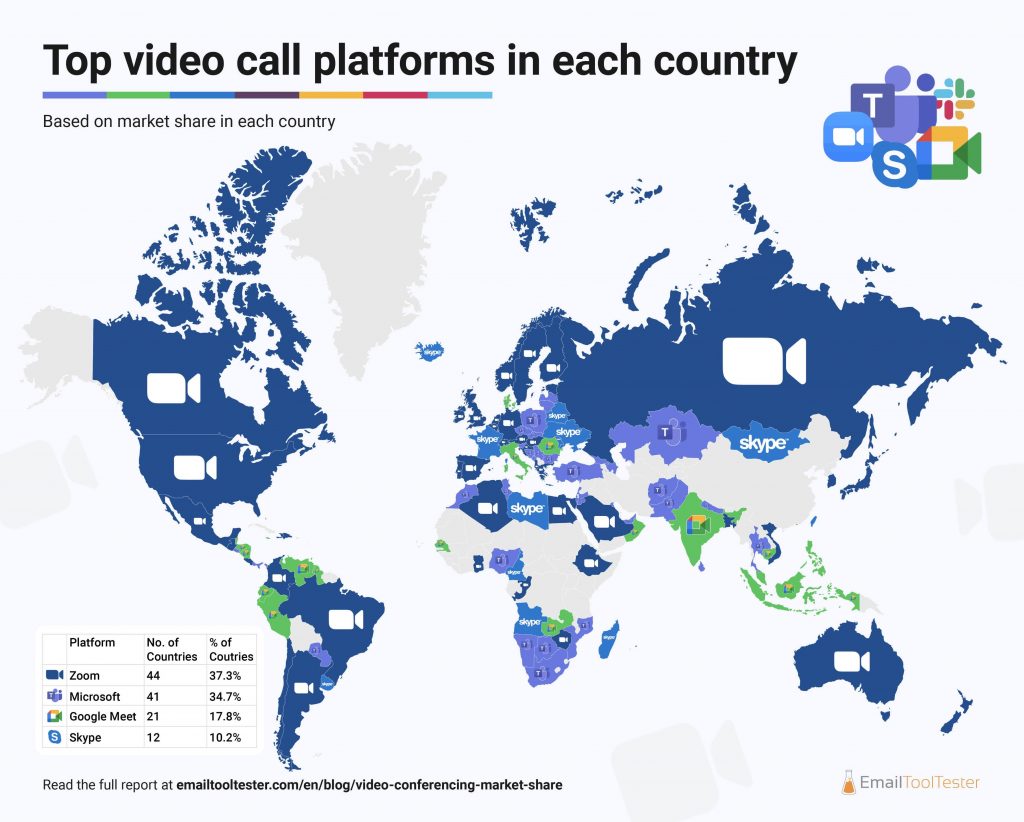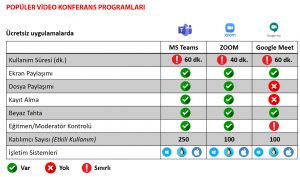Social distancing measures, and accordingly the remote working model, continue to increase as a result of the COVID-19 pandemic. In consequence, the frequency of the use of video conferencing software and other work tools has reached record levels (Hughes, 2020)[1].
According to a report dated March 2021, the percentage distribution of the most used video conferencing software in the world is as follows[2][3]:

When we look at the map, we see that Microsoft Teams and Zoom take the lead in terms of the number of users in Turkey and also worldwide. Google Meet by Google, which is very different from its competitors, ranks third. See the table below for the free versions of the basic functions of these three video conferencing systems:

Microsoft Teams, with functions ranging from adding a background to live stream and Microsoft 365 integration, is one of the most frequently used video conferencing software. It also stands out with its function of recording the meeting. It dominates especially in the Europe, Middle Asia and Africa markets.
With its easy to use structure and fun visual effects the other rising star of the pandemic is Zoom. Being the leader especially in North and South America and former Soviet Republics markets; Zoom reported 185.7 million dollars net profit with approximately 3.300% increase compared to last year[4].
As one of the technology leaders, Google Meet also claimed its position in the ranking. When the software is analyzed it can be seen that the absence of some functions such as recording the meeting and sharing embedded video sounds in presentations caused this software to fall behind of its competitors. However, it is the lead in some European countries, India and some markets in the far east thanks to the popularity of Google products.
You should always take your comfort and your goals into account when choosing between any video conferencing software whether for educational, meeting, or socializing purposes.
Keep in mind that these software are important tools for achieving your goals.
Mustafa Sünger
Kızılay Academy E-Learning Products and Systems Specialist
References:
- Hughes, O. (2020, May 4). Zoom vs Microsoft Teams vs Google Meet: How do they compare? https://www.techrepublic.com/article/zoom-vs-microsoft-teams-vs-google-meet-how-do-they-compare/. (↑ References 1)
- Brandl, R. (2021, March 24). Video Call Victories: map reveals the most popular video conferencing platforms worldwide. EmailToolTester.com. https://www.emailtooltester.com/en/blog/video-conferencing-market-share/. (↑ References 2)
- (n.d.). Top Video Call Platforms Raw Data – EmailToolTester. Google Sheets. https://docs.google.com/spreadsheets/d/1Zl2rlNCVTm0m_kX9_zQCc45xFOF1MS7Xzfyh7XGFOmk/edit#gid=0. (↑ References 3)
- He, L. (2020, September 1). Zoom profit skyrockets 3,300% on remote work trend. CNN. https://edition.cnn.com/2020/09/01/tech/zoom-profits/index.html. (↑ References 4)

